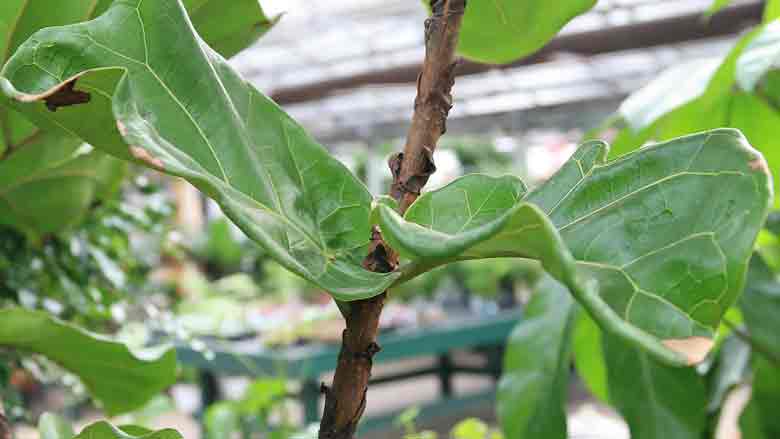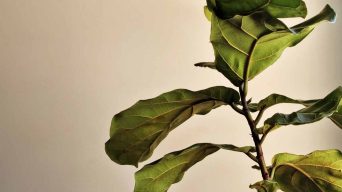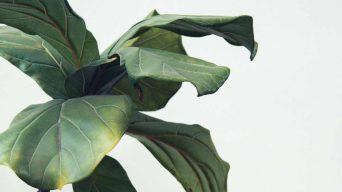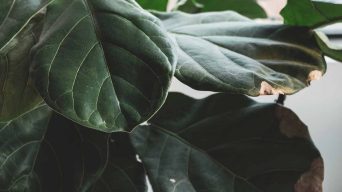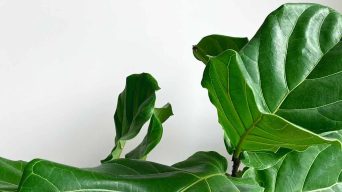Brown spots on fiddle leaf fig leaves often signal watering issues. Overwatering or poor drainage can cause these spots, leading to fungal infections like root rot. Dryness and excessive sunlight can also contribute, showing as light brown spots around leaf edges.
Fiddle leaf figs (Ficus lyrata) are popular indoor plants from the Moraceae family, renowned for their large, glossy leaves that vary in color from deep green to light green with yellowish veins, making them a stunning addition to any home.
However, these dark green leaves can sometimes develop brown spots.
There are several reasons why this might occur, including sun damage, underwatering, or pest infestation.
Fortunately, a few simple treatment options can help eliminate the brown spots and keep your plant healthy.
Here’s everything you need to know about brown spots on fiddle leaf figs, including the different causes and how to treat them effectively.
What Causes Brown Spots on Fiddle Leaf Fig Leaves and How to Address Them
There are several reasons why brown spots may appear on the leaves of your Ficus lyrata.
To effectively address this issue, it is crucial to identify the underlying cause. Doing so will enable you to take the necessary steps to remedy the problem and prevent its recurrence.
Some of the most prevalent causes of brown spots on fiddle leaf fig trees include:
1. Sunburn
Fiddle leaf figs are native to the tropical rainforests of Africa.
In their natural habitat, are used to living in conditions where they receive indirect sunlight.
When placed in a new environment, such as a home or office, they may need more time to adjust to the change in lighting conditions.
If your fiddle leaf fig plant is placed in an area that receives harsh direct sunlight, it may experience sunburn.
Leaf burn often appears as light brown spots on the leaves with a yellow ring around the edges.
The fiddle fig leaves will turn brown and may even fall off.
Treating Sunburn Damage
If your fiddle leaf fig leaves have been damaged by sunburn, it is best to cut off the affected leaves.
You can do this with a sharp pair of scissors or pruning shears.
Once you have removed the damaged leaves, you should move your fiddle leaf fig plant to a partially shaded area that will receive bright indirect sunlight.
The best place for your fiddle leaf fig is an east- or west-facing window, as the sun will not be as harsh in these areas.
You can also use a sheer curtain to filter the light.
Once you have moved your fiddle leaf fig to a different location, give it a few days to adjust to the new light conditions.
The leaves should start to grow back after a few weeks.
2. Underwatering
One of the most common reasons for brown spots on your fiddle leaf fig tree is underwatering. This means that you are not giving your plant enough water, and it cannot absorb the moisture it needs to stay healthy.
Inconsistent watering can cause brown spots on the leaves of your fiddle leaf fig tree.
You can also tell if it is not getting enough water if the Fiddle Leaf Fig leaves are drooping.
Addressing an Underwatered Plant
If you think your fiddle leaf fig is underwatered, you first need to check the soil.
The soil should be moist but not soggy.
If the soil is dry, it is important to water your plant immediately to avoid the dryness from causing damage to the roots and leaves of the plant.
You should also check the drainage of your pot.
Make sure the pot has holes in the bottom to drain the water.
If the pot does not have holes, your plant’s roots will start to rot, and the plant will die.
Once you have checked the soil and drainage, you should water your fiddle leaf fig once a week.
Using a moisture meter, you can easily check the soil’s moisture level to ensure that the fiddle leaf fig is getting the right amount of water and that the soil is not too dry or too wet.
Be sure to give it enough water so the soil is moist but not soggy.
After you have watered your fiddle leaf fig plant, give it time to dry before watering it again.
3. Overwatering
Overwatering is a serious problem that causes fiddle fig brown spots. This happens when you give your plant too much water, it has poor drainage, and the roots cannot absorb the soil moisture.
The excess water will pool in the pot, and the roots will begin to rot.
The root ball of the plant is essential for its health, as it helps to anchor the plant in the soil, absorb water and nutrients, and store energy, so if it is not properly taken care of, the plant will not be able to take in the nutrients it needs to survive, and the leaves will turn brown.
You can tell if your fiddle leaf fig is being overwatered if the leaves are wilting, or if the pot is constantly wet. Leaf drop and yellowing of the leaves can also be a sign.
Managing an Overwatered Plant
If you think your fiddle leaf fig is getting too much water, you first need to stop watering it.
Let the pot dry out completely before you water it again.
You may also need to repot your plant in a pot with drainage holes to help the excess water drain out.
In addition to repotting your plant in a pot with drainage holes to help the excess water drain out, it is important to ensure that the potting soil is well aerated so that air can circulate freely, allowing the roots to breathe and access the oxygen they need to thrive.
Once you have repotted your plant, water it only when the top two inches of soil are dry.
4. Low Humidity
Fiddle leaf figs are finicky plants that require just the right amount of humidity to stay healthy.
If the humidity levels drop too low, the leaves will turn brown and drop off. This is because low humidity causes the leaves to lose moisture faster than they can replace it.
Symptoms of this dehydration include wilting, yellowing, and browning of the leaves, as well as a decrease in growth rate and eventual death of the plant if the moisture loss is not replaced quickly enough.
In addition to causing dry brown spots and crispy brown leaf edges, low humidity can make the leaves more susceptible to pests and diseases.
Dealing with Low Humidity Conditions
If the humidity levels are too low, you can do a few things to raise the humidity.
One way to do this is to mist your plants with water daily.
You can also place your plant on a pebble tray.
Fill a tray with pebbles and water, and place your plant on top of the pebbles.
The water will evaporate and raise the humidity around your plant.
You can also try using a humidifier.
5. Nutrient Deficiencies
Not as common as the other reasons on this list, nutrient deficiencies can also cause brown spots on your fiddle leaf fig. This happens when the plant is not getting the nutrients it needs to stay healthy.
Magnesium, Calcium, Iron, or Phosphorus are the most frequent nutrient deficiencies that cause brown tips.
The lack of these nutrients is usually caused by the plant not getting enough water or the soil not having enough nutrients.
Addressing Nutrient Deficiencies
If you think your plant is not getting the nutrients it needs, you can try fertilizing it.
Fertilize during the growing season using a half-strength fertilizer.
Follow the instructions on the fertilizer package for the best results.
You can also try using a liquid fertilizer.
Add the liquid fertilizer to the water when you water your plant.
You should also make sure that you are watering your plants enough.
The water will help the plant absorb its nutrients to stay healthy.
6. Fertilizer Burn
Fertilizer burn is another common reason for fiddle leaf fig brown spots. This happens when you use too much fertilizer or fertilize too often.
The fertilizer will build up in the soil and burn the plant’s roots.
As a result, the leaves will develop dark spots and brown edges.
You can also get fertilizer burn if you use a very strong fertilizer.
Managing Fertilizer Burn
If you think your plant has fertilizer burn, you must stop fertilizing it.
Let the soil dry out completely, and then flush it with water to remove the excess fertilizer.
To prevent fertilizer burn in the future, use a half-strength fertilizer and follow the instructions on the package.
Fertilize your plant during the growing season and take a break during the winter.
You should also make sure that you are watering your plants enough.
The water will help dilute the fertilizer and prevent it from building in the soil.
7. Pest Infestation
Pests are another common problem that causes brown spots on fiddle leaf figs.
Aphids, spider mites, fungus gnats, and scale insects are the most common plant pests that attack fiddle leaf figs.
These pests suck the sap out of the leaves, causing them to turn brown and die.
Insect damage can cause a variety of problems for plants, including brown spots, yellow leaves, and distorted growth, ultimately leading to the death of the plant if left unchecked.
Pests can also spread diseases from one plant to another.
Dealing with Pests
If you think your plant has pests, you first need to isolate it from other plants. This will prevent the pests from spreading to other plants.
You can treat most pests with natural remedies such as insecticidal soap or neem oil.
Mix the insecticidal soap or neem oil with water according to the instructions on the package.
Spray the mixture on the top and underside of the plant, making sure to cover all of the affected areas, and follow the instructions on the package for best results.
You must treat your plants every few days until the pests are gone.
8. Leaf Spot Diseases
Leaf spot diseases are another common reason for dark brown or black spots on fiddle leaf fig plants.
These diseases are caused by fungi or bacteria that infect the plant’s leaves.
Infections can cause the leaves of a plant to become discolored, wilted, and distorted, resulting in an unhealthy and unattractive plant; in extreme cases, the entire leaf may turn brown and fall off due to the spread of fungal, bacterial, or viral infections.
The most common leaf spot diseases include:
- Rust
- Bacterial Leaf Spot
- Anthracnose
- Fungal Leaf Spots
Treating Leaf Spot Diseases
If you think your houseplant has a leaf spot infection, you first need to isolate it from other plants.
This will prevent the disease from spreading to other plants.
Make sure that the plant is getting enough natural light.
Leaf spot diseases are often caused by too little light, so increasing the amount of light your plant receives can help to prevent the disease from spreading.
Water the plant from the bottom up, ensuring the roots absorb moisture before the leaves do. This will help prevent the leaves from getting too wet, which can exacerbate the fungal and bacterial spots.
Also, remove any affected leaves and dispose of them properly.
These simple steps can help your fiddle leaf fig recover from leaf spot disease and stay healthy.
9. Fungal Root Rot
Fiddle leaf figs are susceptible to root rot, which can cause brown tips and small black spots on the leaves.
Root rot is a condition caused by overwatering, which can lead to fungal growth.
When the plant’s roots are waterlogged, they can’t get the oxygen they need to function correctly. This can damage and kill the roots and cause the leaves to turn brown.
You can tell if your plant has fungal root rot if the leaves are wilting, yellowing, or browning and a bad smell is coming from the soil.
The fiddle leaf fig leaves may also fall off. If your plant has root rot, you should take it out of the pot and check the roots. If they’re mushy or black, they’re probably rotting.
Addressing Root Rot
If you think your plant has root rot, the first thing you need to do is remove it from the pot.
Be careful not to damage the roots.
Once you’ve removed the plant from the pot, check the roots for signs of rot.
If they’re mushy or black, they need to be removed.
You can do this by cutting them off with a sharp knife.
Once you’ve removed the rotten roots, you can replant the plant in a fresh, well-draining potting soil mix.
Be sure to water it regularly and avoid overwatering it.
These simple steps can help your fiddle leaf fig recover from root rot and stay healthy.
10. Frost Damage
Fiddle leaf fig brown spots are also caused by frost damage.
Frost damage occurs when the plant’s leaves are exposed to cold temperatures.
When the plant’s leaves are exposed to cold temperatures, the edges of the leaves can become brittle and dry, eventually leading to the leaves turning brown and dying.
Protecting your plants from the cold is vital if you live in an area with frost.
You can cover them with a sheet or tarp when the weather is cold.
You should also move them indoors.
Managing Frost Damage
If you think your plant has frost damage, the first thing you need to do is remove it from the cold.
Bring your outdoor plants inside, and move indoor plants to a warmer location.
Once the plant is in a warm spot, check the fiddle leaf fig leaves for signs of frost damage.
If they’re brown and wilted, they need to be removed.
To remove a damaged leaf, use a sharp knife or pruning shears.
Cut the brown leaves off at the point where they meet the stem.
Once you’ve removed the damaged leaves, let the plant rest in a warm location until new growth appears.
Preventing Brown Spots on Your Fiddle Leaf Fig Plants
Fiddle leaf figs, the Ficus lyrata, are a popular type of houseplant. Still, when the growing conditions aren’t right, they can suffer from various problems, including brown spots on the leaves.
Fortunately, there are some tips you can take to help prevent and treat these common issues.
Here are a few tips:
- Give your plant enough water. Fiddle leaf figs need to be watered regularly, about once a week. Water them deeply until the water comes out of the drainage holes in the bottom of the pot. Allow the soil to dry out in between waterings.
- Place your plant in the correct location. Fiddle leaf figs need bright indirect light. They can tolerate some direct sunlight, but too much sun will cause the leaves to turn brown.
- Prune your plant regularly. Pruning helps to encourage new growth and also gets rid of any dead or dying leaves that could potentially cause brown spots.
- Inspect your plant regularly for pests. Fiddle leaf figs are susceptible to mealybugs, scale, and spider mites. If you see any of these pests on your houseplants, treat them immediately. Spray the affected areas of the plant with insecticidal soap or neem oil, making sure to get both sides of the leaves and stems to ensure that all of the pests are eliminated.
- Be careful when fertilizing. Too much fertilizer can burn the roots of your fiddle leaf fig and cause the leaves to turn brown. If you fertilize, use a half-strength fertilizer and apply it every two weeks during the growing season.
- Protect your plant from drafts. Fiddle leaf figs are sensitive to cold temperatures and can be damaged by drafts. Keep them away from windows, doors, and any other draft sources.
- Avoid using chemicals on your plant. Chemicals can damage the leaves of your fiddle leaf fig and cause brown spots. Try to use only organic products on your plant.
- Get rid of any dead leaves. Dead leaves can harbor pests or diseases, which can then spread to the rest of your plant. Remove dead leaves from your fiddle leaf fig as soon as you see them.
- Practice good plant hygiene. Keep your fiddle leaf fig clean by dusting the leaves regularly. This will help to prevent any pests or diseases from attacking your plant.
- Don’t stress your plant. Fiddle leaf figs are sensitive to changes in their environment. Try to keep their location and care routine consistent to avoid stressing the plant.
Following these tips, you can prevent brown spots on your houseplant leaves and keep it looking its best.
Final Thoughts
Brown spots on fiddle leaf fig trees are not something to worry about.
They are caused by various factors, including too much sun, lack of water, or even pests.
However, there are ways to treat and prevent fiddle leaf fig leaves from turning brown.
Following the tips in this article, you can keep your fiddle leaf fig tree healthy and free of brown spots.

